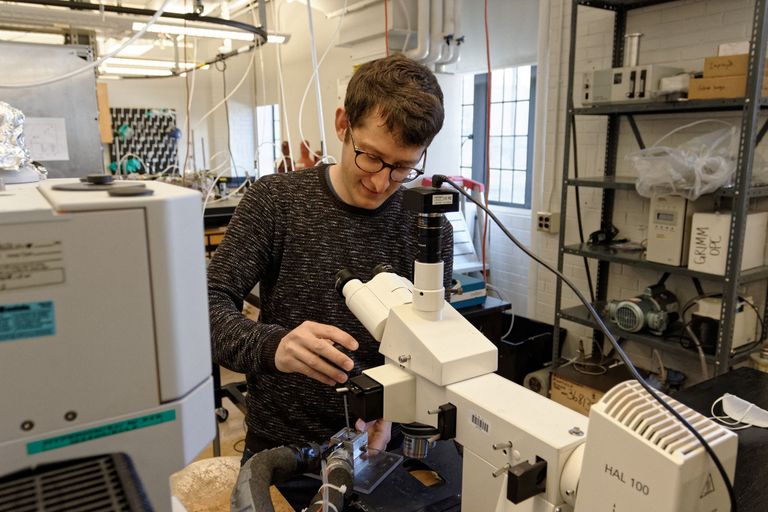Astrid Tomczak-Plewka
At some point, it dawned on Gregor Weiss that he was actually out of place at the high school specialised in teaching languages. That he had not so much to do with languages, but all the more with natural sciences. Responsible for this realization was his chemistry teacher. "She introduced me to the natural sciences," Gregor Weiss says. The high school student made a decision: he would study chemistry. However, not just anywhere, but in a place, where he could indulge his passion, ski touring. That place was Innsbruck. The student had no particular academic ambitions. "I never thought at the time that I would be doing a PhD," he says.
In California, the scientist in him was awakened
That did not change until he went to California for a summer stint as a research assistant. It was there that he first came into contact with a technology that was to determine his future path - cryo-electron microscopy. In this process, biological samples are rapidly frozen, forming a glassy ice. A method for the development of which the Swiss biophysicist Jacques Dubochet received the Nobel Prize in 2017. "This allows us to look at samples in their natural state, without fixatives or contrast agents," Weiss explains.
In California, the scientist was awakened in the undergraduate student. After his return to Innsbruck, a second stay at the California Institute of Technology, and a Master's degree in Vienna, he joined ETH as a doctoral student. There, he investigated the endogenous protein uromodulin in his dissertation. This protects people from urinary tract infections by neutralising E.coli bacteria. However, exactly how this works was unknown until the work of the interdisciplinary Zurich research group. It was able to show that the bacteria recognise certain sugar chains on the surface of the uromodulin and bind strongly to them.
Weiss made a major contribution with his investigations of the protein using cryo-electron tomography. Under the microscope, he discovered that the uromodulin forms long threads, so-called filaments, which on average consist of around 400 individual protein molecules strung together. A single uromodulin filament can dock to several pili, the filamentous appendages of E. coli bacteria. "That neutralises the pathogens," Weiss explains.
A fundamental researcher at heart
And then he tells how he used to race from the laboratory to the hospital on his bike to collect fresh urine samples from patients and then freeze them as quickly as possible. "That collaboration with Children's Hospital that I built was the most beautiful thing for me," he says. His dissertation work could help to treat urinary tract infections preventively and without the use of antibiotics, for example with combined sugar preparations. "It did motivate me," he admits. "But my goal is not primarily to develop a drug. The subject matter itself fascinates me. I am a fundamental researcher at heart."
A milestone in the development of cryo-electron tomography
The Prix Schläfli award is a "great recognition and honour" for him. It confirmed to me that my five years of work were not in vain," says the 31-year-old. The importance of this work is emphasised by his supervisor Martin Pilhofer: "It is a milestone in the development of cryo-electron tomography for the examination of patient samples."
Weiss is currently setting up his own research group at ETH, and the first doctoral student will join him in July. He wants to build on his work with his team. "In my dissertation, I showed how the body can defend itself against urinary tract infections. Our focus now is on how the bacteria organise themselves, how they can colonise the body."
You can only really move forward as a team
Like many others, he dreams of being able to pursue his own ideas in the future – preferably with a professorship. Perhaps his experience in mountain sports will help him in his academic career. "Sometimes the peak already seems within reach – and then suddenly another peak appears," he says. "Even in science, there are many moments that you cannot plan for." Another analogy: "You are never alone on the mountain, it does not work. In research, too, you can only really move forward as a team."





